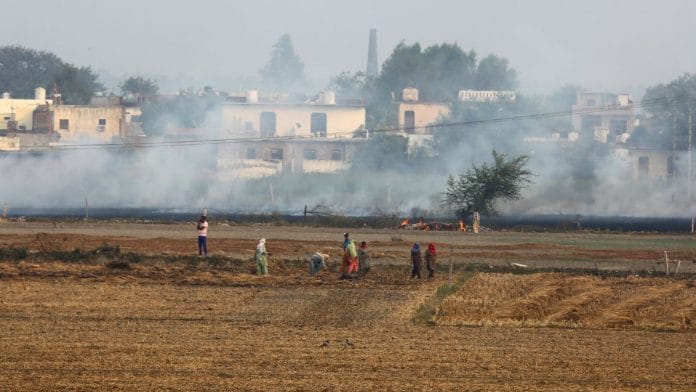Is there a solution to Delhi’s air pollution?
Diwali has passed, and November is almost over, but pollution in Delhi continues to worsen. And not for the first time, politics is mired in allegations and counter-allegations instead of delivering solutions.
Restrictive measures such as school closures, the odd-even traffic rule, and bans on construction activities have already been implemented. Meanwhile, the general public is afraid to step out of their homes. The media largely blames Diwali fireworks, but it is important to note that the PM 2.5 AQI was only 338 on the day of Diwali and rose to 484 about two weeks later.
Delhi’s pollution, compounded by high humidity and low temperatures, traditionally worsens each winter. The situation has deteriorated further in the last decade due to the practice of stubble burning in parts of North India, especially Punjab, Haryana, and Uttar Pradesh.
Every year, in September and October, farmers in these states prepare their fields for sowing wheat after harvesting paddy. Clearing the stubble requires special machines, which are often too expensive for most farmers. As a result, burning the stubble becomes a more economical option.
This large-scale stubble burning continues for about a month and a half, releasing smoke that affects not only surrounding regions but also those farther away. Since Delhi is close to all three states, the impact of stubble burning is practically severe across Delhi and the NCR.
Who is guilty?
Due to the adverse effects of stubble burning on the environment, state governments must take concrete measures to curb the practice. To some extent, they are. Last year, during the 45-day period from 15 September to 29 October, there was a 44.3 per cent reduction in stubble-burning incidents in Punjab, Haryana, Uttar Pradesh, and Rajasthan compared to 2022.
However, out of the total 6,391 stubble-burning incidents during this period, 5,254—82.20 per cent—occurred in Punjab alone, while only 1,094 were reported in Haryana. This means Punjab’s contribution to air pollution from stubble burning was five times that of Haryana.
This year too, as of 3 November, Punjab recorded about 3,165 incidents of stubble burning, compared to 781 in Haryana—a fourfold difference. Of course, it should be noted that the area under paddy production in Punjab is almost double that of Haryana.
Some have used non-representative or irrelevant data to argue that stubble burning accounts for less than 1 per cent of Delhi’s air pollution. The reality is that while stubble burning accounted for 3.19 per cent of Delhi’s pollution on 21 October, this number rose to 35.17 per cent on 1 November (the day after Diwali) and 38 per cent on 15 November.
In November 2019, the Supreme Court reprimanded the Haryana, Punjab, and Uttar Pradesh governments for failing to curb stubble burning. The court directed these states to start giving incentives of Rs 100 per quintal of crop to farmers to discourage stubble burning.
Accordingly, the Haryana government made efforts to dissuade farmers, leading to a dramatic reduction in farm fires over the last two to three years. Punjab, on the other hand, is proving to be a failure in this regard.
Also read: Are Indian farmers pampered or taxed? OECD and WTO are saying two opposing things
Haryana vs Punjab
The Haryana government has been distributing machines such as Super SMS, Rotavator, Happy Seeder, and Zero Till Seed Drill among farmers. Along with discouraging stubble burning, this has also led to increased crop yields. More farmers have now started using these machines, though high rental cost remains a sore point.
The Haryana government has been giving farmers Rs 1,000 per hectare for collecting stubble after harvesting by making bales. Last year, it started offering an additional Rs 1,000 per hectare for in-situ stubble management, which involves practices like mulching to process crop residue directly on the farm. In addition to these positive interventions, the government has also begun imposing hefty fines on farmers who continue to burn straw.
The Haryana government is also incentivising villages in red zones by offering Rs 10 lakh to panchayats that don’t burn stubble. The budgets for these incentives have been increasing every year.
With the same problem and similar circumstances as Haryana, it’s unfortunate that Punjab has failed to address stubble burning year after year. While Haryana has adopted a judicious mix of policies, Punjab has been a laggard state.
Though the Punjab government claims to have invested in machinery, it is proving inadequate for the task at hand. Moreover, efforts to incentivise farmers against stubble burning are completely lacking.
It’s believed that the Punjab government lacks the resources to meet the requisite expenditure. It’s possible that fiscal constraints—due to the ongoing freebies such as free electricity, free bus travel, and other welfare measures—are hindering the state government’s ability to allocate funds toward addressing the problem of stubble burning.
Had even a portion of these freebies been redirected toward incentivising farmers to desist from stubble burning, Punjab would have fared much better. Though the Punjab government has imposed fines of late, it has been unable to desist farmers from giving up stubble burning completely.
Ashwani Mahajan is a professor at PGDAV College, University of Delhi. He tweets @ashwani_mahajan. Views are personal.
(Edited by Prasanna Bachchhav)







excellent piece.
Shameful journalism, neighbouring states are reporting more stubble burning cases plus there are more industries in Himachal baddi and faridabad haryana , but all blame on one state , basically u hate punjab and sikhs